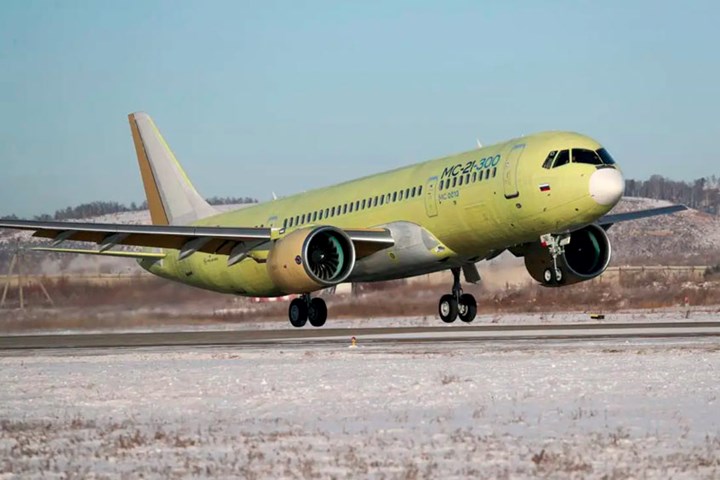MS-21-300 debuts first flight with carbon fiber wing
Certification of the MS-21-300 aircraft is nearing completion, with plans to start delivering it to customers in 2022.

The MS-21-300 aircraft makes its first flight with its new composite infused wing. Photo Credit: UAC
On Dec. 25, ’s (Moscow, Russia) MS-21-300 aircraft, the wing of which is made of Russian-sourced carbon fiber, made its first flight from the airfield of the Irkutsk Aviation Plant.
The aircraft was piloted by a crew consisting of test pilot Roman Taskaev and test pilot Oleg Kononenko. “The flight mission has been completed in full,” says Taskaev. “The aircraft systems were operating normally.”
“In addition to the three aircraft in the final assembly shop, three more MS-21-300 are at different stages of production. All of them will receive a wing made of Russian composites,” notes United Aircraft Corp. (UAC) General Director Yuri Slyusar. “Within the framework of the MS-21 program, a big step has been taken in the development of cooperation between aircraft manufacturing plants in Russia.”
Slyusar says UAC has developed centers of competence within Russia specializing in the production of individual units. Aviastar produces the MS-21 fuselage panels and tail unit, Voronezh VASO the engine pylons and landing gear fairings. AeroComposite-Ulyanovsk manufactures the wing box, wing consoles and the center section of the MS-21-300 aircraft and KAPO-Composite the wing mechanization. Each center is involved in promising projects in the Russian aircraft industry, Slyusar contends.
“The first flight of an aircraft with a wing made of Russian composites proves that we did everything right. The MS-21 program is consistently and steadily moving forward, despite sanctions and unfair competition,” says Denis Manturov, Minister of Industry and Trade of the Russian Federation. “This is the result of the development of the competencies of the aviation industry and related industries and unprecedented government support. The total amount of funds allocated by the Ministry of Industry and Trade of Russia for the creation of domestic materials for the composite wing amounted to 4.4 billion rubles [~$58 million]. The technology introduced for the production of the MS-21 wing has a number of advantages. It, in comparison with traditional autoclave technology, allows you to increase productivity, reduce labor costs and cost and provide the ability to form large parts. To date, a composite wing has been manufactured for two aircraft, [with] the third set [still] being manufactured. We plan to receive changes to the Type Certificate regarding the composite wing in the second half of 2022.”
Domestic materials for the composite wing structures were developed with the participation of scientists from Moscow State University and aviation industry specialists from Rosatom. Qualification tests indicated the materials’ compliance with MS-21 aircraft design requirements. The composite wing was manufacturing using vacuum infusion technologies patented in Russia.
“The share of composites in the MS-21 design is about 40%, which is a record figure for medium-haul aircraft. The use of strong and lightweight composite materials has made it possible to create a wing with unique aerodynamic characteristics unattainable for a metal wing,” says the head of Rostec, Sergey Chemezov. “Improved aerodynamics have made it possible to increase the width of the MS-21 fuselage and expand the cabin, which brings new advantages in terms of passenger comfort. This is the first medium-haul aircraft in the world where such solutions have been applied.”
MS-21-300/310 is a new-generation, medium-range aircraft with a capacity of 163-211 passengers, aiming for the passenger transportation market in Russia and globally. According to Andrey Boginsky, general director of PJSC Irkut Corp., there are plans to start supplying MS-21-300 aircraft to Rossiya Airlines, part of the Aeroflot Group, this year. All production aircraft will be equipped with a composite wing. The aircraft will be delivered in a two-class layout — 16 business class seats and 153 economy class seats.
Related Content
Revisiting the double vacuum debulk process
Evolution of the double vacuum debulk (DVD) process over the years continues to advance its “near autoclave quality” for low-void, highly compacted repair patches.
Read MoreInfused sandwich window frame components help double-decker buses meet weight targets
Prototype GFRP parts were evaluated by Spanish bus manufacturer Carrocerías Ayats as an initial move toward lighter, more efficient, more automated parts and processes.
Read MoreCarbon fiber satellite arm reduces weight, simplifies assembly onto naval vessels
Satcom developer EM Solutions partnered with ACS Australia to replace an aluminum arm design with a 65% lighter, one-piece, corrosion-resistant carbon fiber/epoxy alternative.
Read MoreWe4Ce infused 2.5-3-MW rotor blade design passes validation test
Composite rotor blade structure design by We4Ce, mold and prototype production by InDutch Composites and fatigue testing by Suzlon Group has resulted in the novel blade’s IEC61400-5:2020 certification.
Read MoreRead Next
Next-gen fan blades: Hybrid twin RTM, printed sensors, laser shock disassembly
MORPHO project demonstrates blade with 20% faster RTM cure cycle, uses AI-based monitoring for improved maintenance/life cycle management and proves laser shock disassembly for recycling.
Read MoreScaling up, optimizing the flax fiber composite camper
Greenlander’s Sherpa RV cab, which is largely constructed from flax fiber/bio-epoxy sandwich panels, nears commercial production readiness and next-generation scale-up.
Read MoreCeramic matrix composites: Faster, cheaper, higher temperature
New players proliferate, increasing CMC materials and manufacturing capacity, novel processes and automation to meet demand for higher part volumes and performance.
Read More












